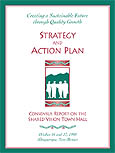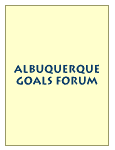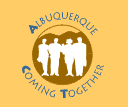  |
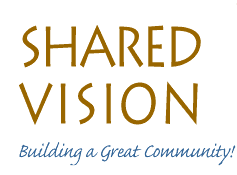 |
  |
|||||||||||||||||||||||||||||||||||||||||||||||||||||||||||||||||||||||||||||
|
"Anatomy of Unified City/ County
Government" "Halfway to a Whole County" Printed in the Albuquerque Tribune by Signe Rich, Executive Director, Shared Vision and Sandra Browne, President, League of Women Voters "Help Bake our New
Urban County Layer Cake" "Form and Composition
of Government" – "Chance to Shape Civic
Framework"
|
|
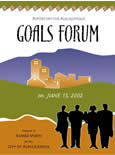
|
2002
GOALS FORUM REPORT
| |
|
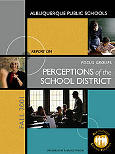 |
FOCUS GROUPS PERCEPTIONS OF THE SCHOOL DISTRICT, for Albuquerque Public Schools, Fall 2001. The report describes the perceptions of six focus groups (teachers, administrators, students, parents, business community and Spanish-speaking parents) towards the school district as a whole, identifying issues such as its size that are perceived to be negative, along with strengths such as its diversity and accessibility to all students. Strategies for dealing with drop-out rates and improving the career value of education surface in the groups.
| |
| |
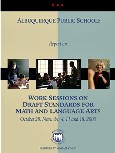 |
APS DRAFT PERFORMANCE STANDARDS: Math and Language Arts Four work sessions were held with teachers, administrators, parents and community in a collaborative dialogue on the need to raise expectations for students through new performance standards and a new emphasis on individualizing teaching to the different levels of each student. The report concludes that the whole system--parents, teachers, community and schools--must be partners in the effort to raise standards and measure performance. The report is a comprehensive, thoughtful look at the Albuquerque educational system and how it can be improved.
| |
| |
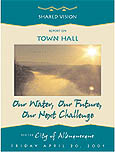 |
OUR WATER. OUR FUTURE. OUR NEXT CHALLENGE. Using the San Juan-Chama Diversion. Albuquerque is about to change the source of its drinking water--moving from total reliance on mining its underground aquifer to using its water allocation from the San Juan-Chama diversion project flowing to the Rio Grande. This report on the town hall held in April 2001 explores how the community can best prepare for this change by using technologies that maintain the river environment, and incorporating education and environmental features into the design of the new facilities for withdrawing and treating river water. The report is an excellent introduction to the technical issues of the river diversion and to the larger water resources strategy for our region.
| |
| |
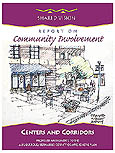 |
CENTERS AND CORRIDORS: Creating Great Streets and Great Places, Report on Community Involvement. This report describes twenty-four community workshops in which neighborhoods responded to a "centers and corridors" proposal by City Planning to increase densities in certain parts of the city. Residents describe their desire for a greater sense of community by creating a more walkable city with places for people to gather. Each part of the metropolitan area receives special attention as to what makes it unique and desirable to the people who live there: Central Albuquerque, East Gateway, East Mountains, Foothills, Mid-Heights, near Heights, North Albuquerque, North Valley, South Valley, Southwest Mesa, and the West Side. Neighborhoods give their ideas on how their interaction with developers and the city can be improved to achieve results more in line with the kinds of communities people want.
| |

| |
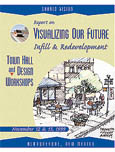 |
VISUALIZING OUR FUTURE: Infill and Redevelopment - Town hall and Design Workshops, Building a Great Community. This report on a major two-day event in November 1999 explores the role of urban design as a tool for building consensus on specific opportunity sites. It provides a context for carrying out the big themes of Centers and Corridors, including a keynote address by UNM Architecture and Planning Dean Roger Schluntz on "How Good Cities Become Great Cities", discussion of redevelopment processes in Tempe, Arizona and Austin, Texas, and a dialogue with developers and community representatives on the complex issue of how to raise the quality and feasibility of infill development in Albuquerque. It offers a vision for creating a "Great Street" and presents visuals produced by architects in seven charettes or design workshops for Central Avenue opportunity sites, demonstrating the results of constructive community involvement.
| |
| |
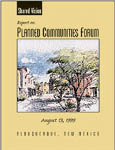 |
PLANNED COMMUNITIES FORUM, Results of Public Involvement. This report addresses both planned communities in new areas, offering opportunities to create communities that provide the lifestyle many people aspire to; and the planning of existing communities to make them more livable. The report highlights and provides visuals from successful planned communities throughout the country including Civano outside of Tucson. For new communities, it addresses their location, phasing, and standards along with accompanying regulatory, land use and fiscal strategies for a more intentional approach to growth.
| |
| |
|
FROM VISION TO ACTION: Creating a Sustainable Future through Quality Growth, Strategy and Action Plan. Participants in this town hall believed that the Albuquerque metropolitan area should not continue to grow as it has been. "Growth must be planned and plans must be followed." The report features panel discussions of growth strategies by visiting mayors of San Antonio, Denver, Austin, and Fort Collins and presents succinct recommendations for how Albuquerque should grow with greater emphasis on infill and planned communities. This is the first in a series of four town halls held from 1998-2001 focusing on quality growth, which together provide a legacy of innovative thinking by the community on growth issues.
| |
|
|
Albuquerque Goals Forum. The report describes a vision and seven goals for Albuquerque in the areas of: Sustainable Community Development, Public Systems, Community Building, Economic Vitality, Human and Family Development, Environmental Protection and Enhancement, and Public Safety. It reflects two days of discussion among Albuquerque citizens regarding their desired future and the core values that led to creation of a vision statement.
| |
|
Published copies of these
reports are also available from Shared Vision by calling 764-6078. BACK TO TOP |
| |
||||||||||||||||||||||||||||||||
